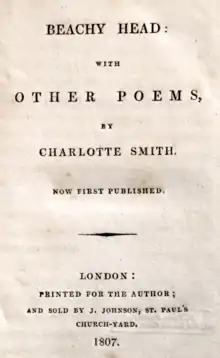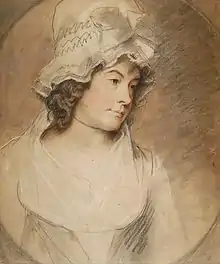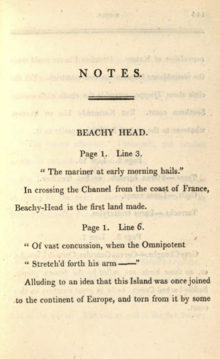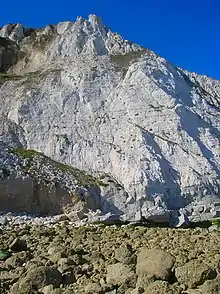Beachy Head (poem)
Beachy Head is a long blank verse poem by Charlotte Turner Smith, first published in 1807 as part of the volume Beachy Head and Other Poems. The poem imagines events at the coastal cliffs of Beachy Head from across England's history, to meditate on what Smith saw as the modern corruption caused by commerce and nationalism. It was her last poetic work, published posthumously, and has been described as her most poetically ambitious work.[1] As a Romantic poem, it is notable for its naturalist rather than sublime presentation of the natural world.[1][2][3][4]
| by Charlotte Turner Smith | |
 Title page of the first edition | |
| Written | 1806 |
|---|---|
| Country | England |
| Language | English |
| Meter | iambic pentameter |
| Rhyme scheme | blank verse |
| Publication date | January 1807 |
| Lines | 742 |
Composition

Smith began writing Beachy Head in 1803,[5] the same year that England and France ended their one year of peace between the French Revolutionary Wars and the Napoleonic Wars. At this time, Smith lived in cheap housing near Beachy Head, in poverty due to debt caused by her estranged husband, Benjamin Smith.[6] Her novels had stopped selling well as readers were less sympathetic to her revolutionary political views, and she sold her personal library of 500 books to support herself.[7] She was also increasingly ill during these years, with rheumatoid arthritis making it difficult to write, and sometimes immobilizing her.[7]
Smith continued to write and revise Beachy Head for the next three years.[5] She also wrote extensive footnotes to the poem.[8] She sent a draft of the poem and notes to her publisher Joseph Johnson in May 1806.[9] Smith died on October 28, 1807, and her relatives took over the task of publishing her works.[9] According to the preface, the publication of Beachy Head was delayed because the publisher wanted to locate a preface possibly written by Smith, and to add a biography of her life, but ultimately it was published without these materials.[9] The poem finally appeared in print January 31, 1807, as the first poem of the volume Beachy Head and Other Poems.[9]
The preface written by Smith's publisher states that the poem was "not completed according to the original design," though Smith's last letter to Johnson does not mention intended revisions to the poem other than footnotes.[1] Some scholars have concluded that Smith intended to add a short epitaph to the end of the poem.[10] Others, however, believe that the poem intentionally falls within the genre of the Romantic fragment poem.[11] In this reading, it has been suggested that the incomplete elements are the missing memoir or preface.[1]
Poem
.jpg.webp)
Synopsis
The poem does not present a narrative, but rather a loose meditation on the history of England and humanity's relationship with nature, addressed in an extended apostrophe to the "muse" of Beachy Head. Throughout the poem, the speaker imagines or remembers Beachy Head while regretting being separated from it. The first two stanzas imagine the events of a single day, beginning with dawn on the coast and the departure of fishing boats. A departing merchant ship prompts the speaker to criticize consumerism of luxury goods. The sun sets, the fishing boats return, and smugglers use the coast in darkness. In the third stanza, the poem shifts back in time to describe the history of Beachy Head during the Norman conquest.
The sixth stanza returns to the present day, beginning an extended pastoral section. The poem describes a shepherd, deviating from typical pastoral poetry by demonstrating the rough and laborious realities of peasant life, rather than presenting idealized conventions. The poem describes two village children, whose innocence allows them happiness which the speaker compares to her own lost idyllic childhood. In the eighth stanza, the poem moves to look down upon the roofs of houses in the village, the church, and gardens, describing the bountiful local plants.
The eleventh stanza introduces natural history with the memory of a fossilized seashell found at the top of a cliff. This begins a sequence discussing the limits of science and ambition. The speaker describes how the successive wars fought in the area have not led to lasting glory for the combatants, but have been forgotten. The thirteenth stanza turns away from the futility of war to the more attractive image of the contemporary shepherd, and an imaginary long-distance view of peaceful life in England.
The fifteenth stanza begins a story of a "stranger" who used to live in a ruined castle, wandering and singing. Two fragments of his songs are included, by which he is remembered. He seems to remind the poem's speaker of another solitary but enviable figure, a hermit who lived at the base of the cliffs at Beachy Head. In the nineteenth blank verse stanza, the poem introduces a hermit, who lived a harsh life of exile, but demonstrated virtue by risking his life to rescue sailors from shipwrecks during storms, burying those he could not save. After a particularly terrible storm, the hermit was himself found drowned, and he was buried by shepherds.
The poem ends with the statement that "Those who read / Chisel'd within the rock, these mournful lines, / Memorials of his sufferings, did not grieve," but unlike with the stranger's songs, no "mournful lines" are included in the poem. Some have interpreted these lines to indicate that Smith intended to add more verses to the poem,[10] while others consider the poem to be complete.[11]
Style
Poetic form
The poem consists of 742 lines, in twenty-one blank verse stanzas of varying lengths, with two inserted rhyming poems that add nineteen additional stanzas.[12] It is accompanied by sixty-four footnotes written by Smith.[12]
Unlike Smith's most famous poems, her Elegiac Sonnets, Beachy Head does not follow a strict poetic convention or fall into a clear genre. In one scholar's words, the poem "forgoes the sonnets' crisp circumspection for expansive blank verse paragraphs."[13] Donelle Ruwe describes the resulting genre as "a greater romantic lyric fragment",[12] and others have also interpreted the poem as an intentional literary fragment.[11][14] As a "dependent fragment poem," which relies on its relationship to its authors' other works for its full interpretation, Beachy Head is the first Romantic dependent fragment poem, with John Keats' two fragmented epics as the last.[11]
The poem combines elements of epic, pastoral, and georgic poetry.[1] It is also often considered a "prospect poem," a popular Romantic genre of poem which presents, and often praises, an external landscape.[15] For these scholars, Beachy Head is "in the first instance a place-related poem, a poem which both describes and constructs place, inscribing it into the imagination of its readers and into cultural history."[16] In this reading, the poem's blank verse paragraphs are often seen as physically resembling the cliffs themselves, akin to concrete poetry.[17]
Poetic speaker
The first half of the poem is narrated from a first-person perspective.[3] Although the speaker is never named, the narrating style is arguably similar to that which is used in the footnotes, suggesting it could be interpreted as Smith herself.[5] The speaker looks at the events at Beachy Head in several perspectives.[5] Some scholars emphasize the omniscience of the speaker, transcending human perspectives,[18][19] while others see limits to what the speaker is able to describe[6] or examine the speaker's individual personality as a person of sensibility.[20] Although the speaker mentions having previously been present at Beachy Head, the poem is entirely imagined, narrated as a hypothetical vision of what the speaker might see if they could revisit the landscape.
Apostrophe and personification

The poem uses apostrophe throughout to address the subjects it describes, including personified concepts like ambition. The opening apostrophe to the cliffs of Beachy Head is similar to the poetic invocation of a muse common in epic poetry. As the speaker continues to address Beachy Head, it develops a personality within the poem that changes it from a backdrop to almost a character in its own right.[21] Ultimately, Beachy Head is presented "not as an instrument to be exploited and gawked at for sentimentalism's sake, but as a 'lively' companion to be sympathized with and regarded on its own plane of being."[21]
Smith's notes
Smith composed sixty-four notes to accompany the poem,[12] which appeared collected as endnotes in the first edition.[22] These notes provide, among other details, scientific names for plants and animals; descriptions of historical events; and explanations for some of her allusions to other writers. The notes are generally considered an important part of Smith's overall poetic approach.[8][23][15] The notes establish Smith's position as an authority in areas ranging from historical contexts, to geological insights, and scientific examinations of wildlife.[23] Smith's invocation of herself as an expert has been considered particularly impressive since these notes were composed after she sold her personal library, and thus the many facts and quotations included are based solely on her own memory; some quotations are, as a result, not word-perfect, but in general Smith's notes are remarkably accurate. By introducing academic topics, the notes also extend the boundaries of poetry, tying science to poetry in a symbiotic relationship.[8] The combination of approaches mirrors the poem's presentation of the cliff itself as, in one scholar's words, "complex, many-layered, unfinished, and caught up in a continuous process of becoming,"[8] by describing the landscape in multiple ways simultaneously.[8]
Background

Threats of French invasion
England and France were at war from 1792 to 1802 in the French Revolutionary Wars, and after a brief period of peace, returned to war in 1803 with the Napoleonic Wars.[6] By 1805, tensions between the British and French were at their highest pitch, and many Britons feared an imminent invasion by the French.[6] Beachy Head was considered a likely beachhead for the anticipated French invasion of England,[24] and British soldiers were stationed at Beachy Head as part of the British countermeasures.[6] The 1690 Battle of Beachy Head, in which the English navy was defeated by the French, was often discussed in eighteenth century histories of invasion.[9] Beachy Head as a location, therefore, called France to mind as a threat.[25]
Smith has been called a "French Revolution poet,"[6] and frequently wrote in response to the political discourse, events, and philosophy of France.[26][27] Smith supported French revolutionary ideals, especially ideals of radical cosmopolitanism and egalitarianism.[26] In Beachy Head, Smith is "figuratively always looking across the Channel"[20] at France. Beachy Head was chosen as a subject in part because "Smith imagined England as divided from the Continent most thinly by the Channel at this very spot."[28] Smith drew attention to this closeness with her first footnote in the poem,[28] which points out: "In crossing the Channel, from the coast of France, Beachy-Head is the first land made."[22] The poem further highlights the context of the invasion threats by describing the 1690 Battle of Beachy Head, as well as the much earlier successive invasions of England: the Roman conquest of Britain beginning 48 AD, the Danish conquest of England beginning 1015 AD, and the Norman conquest in 1066, which are all imagined to have happened in the same spot.[29] Smith therefore put her contemporaries' "watchful apprehension of what lay beyond the Channel coast"[30] into a broader historical context.[31]
Romanticism
Smith's first published work, Elegiac Sonnets (1784), had been an influential early text in the literary movement which would come to be known as Romanticism.[9] Smith's sonnets differed from previous sonnets in both subject matter and tone.[32] Smith wrote about her personal troubles, rather than love, and created an overall feeling of bleak sadness.[9] She also used less complex rhyme schemes, to write sonnets that were sometimes criticized for their simplicity[33] but have also been seen as pursuing more natural, more direct poetic language which matched the emotions she expressed better than the artificial language common to Italian sonnets.[34] This pursuit of simple, direct expression is among the reasons Smith is classed as a Romantic poet, and partly inspired the poetic innovations of William Wordsworth and Samuel Taylor Coleridge's Lyrical Ballads (1798).[35] Beachy Head challenges some conventions of Romantic poetry. For example, the poem evokes the Romantic idea of individual genius, but in a way that is "inflected by a desire to challenge social constructions of individuality."[36]
Major themes
Naturalist approach to nature
_(cropped).jpg.webp)
Like other Romantic poets, Smith considered the natural world to be of great importance, and nature plays a major role in her poetry. Unlike other Romantics, however, Smith's presentation of nature does not attempt to transcend, transform, abstract, or absorb the natural world.[37][38] As such, the poem's presentation of nature has been discussed as providing a contrast to other Romantic poetry, especially that of William Wordsworth[2][3][4] or Percy Shelley's Mont Blanc.[1]
One distinctive element of Smith's treatment of nature is her attention to scientific accuracy. Beachy Head is noted for its "microscopic"[1] attention to the detailed reality of plants and fossils, embracing natural history as the means through which to understand nature.[3][4] Smith's interest in botany and ornithology is reflected in her footnotes describing the scientific names of fifty-one species of birds and plants.[39] The botanical accuracy of Smith's poems was a hallmark of her writing from her first book, Elegiac Sonnets, which the later poet John Clare praised "because she wrote more from what she had seen of nature then [sic] from what she had read of it."[40] Smith's eagerness to understand and describe the details of the natural world scientifically is contrasted with the "infinite, unthinkable"[1] scope of nature in poems like The Prelude and Mont Blanc.[1][3][4]
Smith's approach to nature is also distinct for showing human activity as an integral part of the natural world, and embracing human stewardship of land and animals, which has been described as representing a "social ecology."[41] Literary scholars interested in ecocriticism have described Smith as "one of the first social ecologist poets."[42] Beachy Head is seen as calling for a more sustainable, more intimate relationship with nature, rather than treating the natural world as a resource to be exploited. In this way, Smith no longer seems to contrast with other Romantic attitudes toward nature. Instead, her interest in scientific minutiae is seen as a way of expanding the "green language" of Romanticism itself.[28] The concept of "green language" was defined in Raymond Williams's 1973 monograph The Country and the City as a new way of writing about nature exemplified by William Wordsworth and John Clare, which combines "a deep sensitivity for natural phenomena with forceful environmental advocacy."[43] Smith's "green language," according to Donna Landry, is "botanically exact and scientific yet charged with feeling," accomplishing the same goals with different rhetoric.[44]
Pastoral critique of commerce

Pastoral poetry conventionally presents the rural poor as innocent and carefree, in contrast with corrupt and unhappy urban dwellers. Often, this contrast also involves an unrealistically idealized image of daily life in rural communities. Smith's depiction of rural life and multiple shepherd characters both evokes and subverts the traditional pastoral mode.[14] In keeping with common pastoral themes, Smith ennobles the hardships of the rural poor, and criticizes the luxuries of the rich.[45] Smith juxtaposes pastoral happiness with the history of commerce as a way of revealing the unethical and exploitative nature of trade, which is harmful both to humanity and to nature.[46] She especially criticizes the phenomenon of shepherds and farmers abandoning rural labor in favour of smuggling, now that war with France has increased the demand for smuggled goods.[47] The poem thus eulogizes "the erstwhile happiness of agrarian and peasant life," a classic pastoral subject.[24]
However, Smith is also realistic about the daily hard work required for rural life.[14] She explores "the Petrarchan oxymoron of un-pastoral shepherds," with a shepherd character who is "neither the passive, suffering observer nor the pastoral fantasy of innocence."[11] Smith also draws a contrast between real shepherds, who "toil with the realities of poverty, demeaning labor, and savage familial relationships," and the character of the "wanderer" who writes poetry about how he imagines his life would be better if he were a shepherd.[48] His ideal images are undermined by juxtaposition with the many real rural labourers who view him with suspicion.[48] As such, although she rejects urban vices and commerce, and sees a form of freedom in the independence possible in rural isolation, Smith also intentionally depicts the oppression caused by wealth inequality, and rejects "the myth of the happy laborer who needs only to work the English countryside to be content."[48]
Human history and geological time

The poem has been described as a dialectical exploration of historiography, placing local personal histories alongside grand national narratives of history.[24] Scholars also draw attention to its relation to the ongoing history being made of the Napoleonic war, and Smith's support of revolutionary efforts in America and France.[1][49] Whereas other Romantic poets, especially Wordsworth, typically respond to significant changes in their society by creating a poetic world which does not include them, Smith's poetry is a "combination of imaginative verse and historical discourse, that refuses to cleanse the poetical vision of the oppression evident all around her."[50] The poem expresses intertwined personal and political turmoil,[1] combining what literary critic Donelle Ruwe describes as "the apocalyptic war rhetoric of the romantic era, as well as ... the celebration of the quotidian."[39]
Also in tension with these personal and national human histories is the sense of a far older geological history. In its frequent descriptions of the stone, the earth, fossilized remains, and buried human remains, the poem is "threaded through by conceptions of a deep earth, of deep time."[19] The theory of plate tectonics would not become widely-accepted for more than a hundred years, but Smith's poem observes evidence of geological change in the presence of fossils on mountaintops and similarities between the French and English shores. Her footnotes mention Nicolas Desmarest's 1751 theory that France and Great Britain were formerly joined by a land bridge, which was broken by some sort of "revolution" in the Earth itself. Smith links Desmarest's geological "revolution" to the ongoing political revolutions in Europe, placing them on a long and ongoing timescale whose ultimate results are impossible to imagine.[6] However, she does not consider Desmarest's theory, or any other geological theories (such as neptunism and plutonism) fully satisfactory explanations, since they ignored fossil evidence.[51] For Smith, the geological and archeological findings at Beachy Head highlight the limits of human pride and scientific accomplishment.[14]
Alternative form of the sublime
_found_at_the_entrance_of_the_cave_N%C2%B0_2_de_la_Roche_Fouet_-_Coll._J.C.Staigre.jpg.webp)
A major eighteenth century aesthetic framework was the opposition between the beautiful (or picturesque) and the sublime, especially as described in Edmund Burke's A Philosophical Enquiry into the Origin of Our Ideas of the Sublime and Beautiful (1757). The binary was conventionally a gendered one: beautiful sights are delicate, domestic, and feminine; sublime sights are awe-inspiring, alien, and masculine.[24] Beachy Head as a whole is often interpreted as presenting either a anti-sublime viewpoint or a new definition of the sublime, in resistance to this gendered binary.[3][24] Unlike Wordsworth's description of the River Wye in "Tintern Abbey" or Shelley's description of Mont Blanc in "Mont Blanc", Smith's description of Beachy Head "shows no fear that she may lose herself in contemplation and shows no need to master or struggle against the nature she describes."[52] If the poem depicts sublime encounters, they are "not found in an overwhelming grandeur but in the infinite within the finite," such as the precise details of flower petals and seashells when closely examined.[52]
The doubled hermit figure
.jpg.webp)
Hermits often appear in Romantic poetry to symbolize disillusion with the society which the hermit has abandoned. Beachy Head features two reclusive figures: the first is a wandering stranger poet, and the second is a hermit who lives at the base of the cliff. Many scholars emphasize a "marked contrast" between the second hermit and the "egocentric and unproductive" wandering poet.[53][20] The contrast between the two recluses has been interpreted as a critique of selfish individualism in other Romantic poetry. In this context, "[t]he altruism and usefulness of the final Hermit figure ... challenge[s] the self-absorption of the solitary poet recluse who precedes him in the poem," making the second hermit praiseworthy because he "has weathered the trajectory of hope and disillusionment-- so familiar to us from canonical Romanticism-- with his sensibility, his humanitarianism, and his commitment to individual action still intact."[54]
Other scholars see the two recluse figures as largely similar, or accomplishing the same effect. Anne Wallace, for example, argues that both figures contribute to an overall intermingling of living and non-living entities in the poem: "Both the hermit of the rocks and his immediate predecessor in the poem, the stranger-poet, compound this indistinguishability, since the narrative places them in conditions that are neither clearly life, nor clearly death... And in not insisting on these sharp boundaries, in taking up residence (as it were) where the borders are constantly open, constantly crossed, the hermit and the stranger-poet also achieve a perhaps enviable condition of 'not-unhappiness.'"[55]
Influences
.jpg.webp)
Smith's political philosophy was influenced by French philosophers and the ideals of radical cosmopolitanism and egalitarianism.[26] She also engages with Adam Smith's Theory of Moral Sentiments (1759) and Anna Barbauld's Inquiry into Those Kinds of Distress which Excite Agreeable Sensations (1773), which present compassion, sympathy, and reason in terms of gendered binaries that Smith rejects.[21]
Poetically, Smith is most strongly influenced by William Cowper and Erasmus Darwin.[56] Darwin's scientific and poetic work, especially The Love of the Plants (1789) serves as a precursor for Smith's naturalist poetics, including her interest in minutiae and references to Linnean classification.[57][21] The poem also shows the influence of John Milton's Paradise Lost through her geological depictions, which mirror Milton's description of Creation.[6]
Among the Romantic poets, William Wordsworth is most often discussed closely with Smith. Over their parallel poetic careers, their poetry often shares themes, subjects, and speakers.[58] Often, Smith is described as influencing Wordsworth more than she is influenced by him.[59] In Beachy Head, Smith seems to be subtly reminding her readers of Wordsworth's poems, especially his Tintern Abbey.[59][58] As a response to Wordsworth, Beachy Head challenges his poetic priorities and aesthetics.[59]
Reception
Early reception of Beachy Head was largely positive, and used the posthumous publication of the volume as an opportunity to praise Smith's career as a poet.[24] An 1807 review in the Annual Review and History of Literature said that "as a descriptive writer, either in verse or prose, [Smith] was surpassed by few."[60] In 1808, a review in British Critic described Beachy Head: With Other Poems as "some of her best work," calling Smith a "genuine child of genius" whose "poetic feeling and ability have rarely been surpassed by any individual of her sex."[61] Later, in 1825, Alexander Dyce included extracts from Beachy Head in his anthology, Specimens of British Poetesses: Selected and Chronologically Arranged, in which he praised the poem for its "fresh and vivid" descriptions of rural scenery.[62] Dyce praised how Smith's love of botany allowed her to "paint a variety of flowers with a minuteness and a delicacy rarely equaled."[62]
Otherwise, there exists little critical response to Beachy Head in the nineteenth century. As time went on, Smith's poetic legacy emphasized her earliest poems, Elegiac Sonnets, and her novels.[63] These attracted less interest over time, and by the early 1900s Smith was considered a minor writer.[64] A resurgence of scholarly interest in Smith's works, initially prompted by the 1960s and 70s feminist movement's recovery of women's writing, reached a new peak in the 1980s and 1990s, but remained focused on Smith's sonnets and novels.[63] Jacqueline M. Labbe's 2003 book, Charlotte Smith: Romanticism, Poetry, and the Culture of Gender, was the first book-length study of Smith's poetry.[59]
Some critics claim Smith's work has a tendency to "read stiltedly" for modern audiences,[65] though others argue that it "strikes distinctly modern chords" from both a psychological and ecological standpoint.[66]
Adaptations
Beachy Head has been adapted to music by composer Amanda Jacobs and scholar Elizabeth A. Dolan as "The Song Cycles of Beachy Head." The Song Cycles are written for a mezzo soprano voice and adapt lines directly from the poem. The Song Cycles consist of 26 songs, grouped into six cycles: “Fancy’s Day Cycle,” “Historical Contemplation Interlude,” “Happiness Cycle,” “Nature Cycle,” “Stranger’s Cycle,” and “Hermit’s Cycle.” The project was composed after Jacobs and Dolan met at Chawton House in Hampshire, England in 2014, and took two years to complete. In 2017, "The Song Cycles of Beachy Head were recorded live at its premiere at the British Women Writers Association Conference hosted by the University of North Carolina at Chapel Hill, with Dolan as lecturer, Jacobs on piano, and Shelley Waite as mezzo soprano.[67]
Notes
- Singer 2012.
- Tayebi 2004.
- Wallace 2002.
- Ruwe 1999.
- Keane 2012.
- Goodman 2014.
- Blank 2003.
- Erchinger 2018.
- Knowles & Horrocks 2017.
- Fletcher 1998.
- Anderson 2000.
- Ruwe 2016.
- Zimmerman 2007, p. 492.
- Lokke 2008.
- Labbe 2017.
- Radu 2017, p. 443.
- Morton 2014, p. 272.
- Black 2018.
- Wallace 2019.
- Backscheider 2005.
- Holt 2014.
- Smith 1807.
- Heringman 2004.
- Kelley 2004.
- Gurton‐Wachter 2009.
- Craciun 2005.
- Schabert 2014.
- Landry 2000.
- Goodman 2014, p. 988.
- Goodman 2014, p. 984.
- Goodman 2014, p. 989.
- Feldman & Robinson 1999.
- Feldman & Robinson 1999, p. 12.
- Feldman & Robinson 1999, p. 11.
- Black et al. 2010.
- Labbe 2003, p. 8.
- Pascoe 1994, p. 203-204.
- Curran 1993, p. xxviii.
- Ruwe 2016, p. 300.
- Landry 2000, p. 488.
- Landry 2000, p. 487.
- Holt 2014, p. 1.
- McKusick 1991.
- Landry 2000, p. 489.
- Landry 2000, p. 483.
- Haekel 2017.
- Tayebi 2004, p. 135.
- Tayebi 2004, p. 137.
- Bray 1993.
- Tayebi 2004, p. 131.
- Heringman 2004, p. 276.
- Ruwe 1999, p. 127.
- Reinfandt 2013.
- Lokke 2008, p. 41.
- Wallace 2019, p. 9.
- Curran 1993.
- Scarth 2014.
- Labbe 2003.
- Stanton 2006.
- Behrendt 2008, pp. 190–191.
- Behrendt 2008, p. 189.
- Dyce 1825, p. 253.
- Duckling 2008.
- Duckling 2008, p. 217.
- Blain 1990, p. 996.
- Curran 1993, pp. xxvii-xxviii.
- Stanton 2018.
References
- Anderson, John M. (2000). "Beachy Head: The Romantic Fragment Poem As Mosaic". Huntington Library Quarterly. 63 (4): 547–574. doi:10.2307/3817616. ISSN 0018-7895. JSTOR 3817616.
- Backscheider, Paula R. (2005). Eighteenth Century Women Poets and their Poetry: Inventing Agency, Inventing Genre. Baltimore: The Johns Hopkins University Press.
- Behrendt, Stephen C. (2008). "Charlotte Smith, Women Poets, and the Culture of Celebrity". In Labbe, Jacqueline (ed.). Charlotte Smith in British Romanticism. Pickering & Chatto.
- Black, Joseph, ed. (2018). Beachy Head (3 ed.). Broadview Press.
- Black, Joseph; Conolly, Leonard; Flint, Kate; Grundy, Isobel; LePan, Don; Liuzza, Roy; McGann, Jerome J.; Prescott, Anne Lake; Qualls, Barry V.; Waters, Claire, eds. (2010). "Charlotte Smith". The Broadview Anthology of British Literature: The Age of Romanticism. Volume 4 (Second ed.). Broadview Press. pp. 44–45.
- Blank, Antje (2003-06-23). "Charlotte Smith". The Literary Encyclopedia. 1.2.1.06: English Writing and Culture of the Romantic Period, 1789-1837.
- Blain, Virginia (1990). The Feminist Companion to Literature in English: Women Writers from the Middle Ages to the Present. Yacle University Press.
- Bray, Matthew (1993). "Removing the Ango-Saxon Yoke: The Francocentric Vision of Charlotte Smith's Later Works". Nineteenth-Century Literature Criticism. 115: 155–159.
- Craciun, Adriana (2005). British Women Writers and the French Revolution: Citizens of the World. Palgrave.
- Curran, Stuart, ed. (1993). "Introduction". The Poems of Charlotte Smith. New York. pp. xix–xxix.
- Duckling, Louise (2008). "'Tell my Name to Distant Ages': The Literary Fate of Charlotte Smith". In Labbe, Jacqueline (ed.). Charlotte Smith in British Romanticism. Pickering & Chatto. p. 203-217.CS1 maint: ref=harv (link)
- Dyce, Alexander (1825). Specimens of British Poetesses: Selected and Chronologically Arranged. T. Rodd.
- Erchinger, Phillip (2018). "Science, Footnotes, and the Margins of Poetry in Percy B. Shelley's Queen Mab and Charlotte Smith's Beachy Head". European Journal of English Studies. 22 (3): 241–257. doi:10.1080/13825577.2018.1513709. S2CID 150067637.
- Feldman, Paula R.; Robinson, Daniel (1999). A Century of Sonnets: The Romantic-Era Revival, 1750-1850. New York: Oxford University Press. ISBN 978-0-19-511561-1. OCLC 252607495.
- Fletcher, Loraine (1998). Charlotte Smith: A Critical Biography. Palgrave.
- Goodman, Kevis (2014). "Conjectures on Beachy Head: Charlotte Smith's Geological poetics and the grounds of the present". ELH. 81 (3): 983–1006. doi:10.1353/elh.2014.0033. S2CID 161287287.
- Gurton‐Wachter, Lily (2009). ""An Enemy, I suppose, that Nature has made": Charlotte Smith and the natural enemy". European Romantic Review. 20 (2): 197–205. doi:10.1080/10509580902840475. ISSN 1050-9585. S2CID 143498569.
- Haekel, Ralf (2017). "Charlotte Smith, Beachy Head (1807)". Handbook of British Romanticism: 339–358.
- Heringman, Noah (2004). Romantic Rocks, Aesthetic Geology. Ithaca, N.Y.: Cornell University Press.
- Keane, Angela (2012). Revolutionary Women Writers: Charlotte Smith and Helen Maria Williams. Northcote House Publishers.
- Holt, Kelly M. (2014). "Charlotte Smith's Beachy Head: Science and the Dual Affliction of Minute Sympathy". ABO: Interactive Journal for Women in the Arts, 1640-1830. 4. doi:10.5038/2157-7129.4.1.2.
- Kelley, Theresa (2004). "Romantic Histories: Charlotte Smith and Beachy Head". Nineteenth-Century Literature. 59 (3): 281–314. doi:10.1525/ncl.2004.59.3.281.
- Knowles, Claire; Horrocks, Ingrid, eds. (2017). Charlotte Smith: Major Poetic Works. Broadview Press.
- Labbe, Jacqueline M. (2003). Charlotte Smith: Romanticism, Poetry and the Culture of Gender. Manchester University Press. ISBN 9780719060045.
- Labbe, Jacqueline (2017). "Charlotte Smith, Beachy Head". In Wu, Duncan (ed.). A Companion to Romanticism. Oxford, UK: Blackwell Publishers. pp. 221–227. doi:10.1002/9781405165396.ch19. ISBN 978-1-4051-6539-6. OCLC 244174741.
- Landry, Donna (January 2000). "Green Languages? Women Poets as Naturalists in 1653 and 1807". Huntington Library Quarterly. 63 (4): 467–489. doi:10.2307/3817613. ISSN 0018-7895. JSTOR 3817613.CS1 maint: date and year (link)
- Lokke, Kari (2008). "The Figure of the Hermit in Charlotte Smith's Beachy Head". The Wordsworth Circle. 39 (1–2): 38–43. doi:10.1086/TWC24045185.
- McKusick, James C. (1991). "'A language that is ever green': The Ecological Vision of John Clare". University of Toronto Quarterly. 61 (2): 226–249. doi:10.3138/utq.61.2.226. ISSN 1712-5278. S2CID 162295216.
- Morton, Timothy (2014). Material Ecocriticism. Bloomington, Indiana: Indiana University Press. p. 272. ISBN 978-0-253-01395-8.
- Pascoe, Judith (1994). "Female Botanists and the Poetry of Charlotte Smith". In Wilson, Carol Shiner; Haefner, Joel (eds.). Re-Visioning Romanticism. University of Philadelphia Press. pp. 193–209.
- Radu, Anca-Raluca (2017). "Charlotte Smith, Beachy Head (1807)". In Haekel, Ralf (ed.). Handbook of British Romanticism. De Gruyter Inc. p. 443.
- Reinfandt, Christoph (2013). "The textures of Romanticism: exploring Charlotte Smith's Beachy Head (1807)". Proceedings Anglistentag 2012 Potsdam. Universität Tübingen: 99–114. doi:10.15496/publikation-13233. ISBN 978-3-86821-488-8.
- Ruwe, Donelle (1999). "Charlotte Smith's Sublime: Feminine Poetics, Botany, and Beachy Head". Essays in Romanticism. 7 (1): 117–132. doi:10.3828/EIR.7.1.7.
- Ruwe, Donelle (2003). "Benevolent Brothers and Supervising Mothers: Ideology in the Children's Verses of Mary and Charles Lamb and Charlotte Smith". Nineteenth-Century Literature Criticism, Edited by Lynn M. Zott. 125: 337 – via Gale Literature Criticism.
- Ruwe, Donelle (2016). "Charlotte Smith's Beachy Head and the Lyric Mode". Pedagogy. 16 (2): 300–307. doi:10.1215/15314200-3435916. S2CID 147533436.
- Scarth, Kate (2014-08-05). "Elite Metropolitan Culture, Women, and Greater London in Charlotte Smith's Emmeline and Celestina". European Romantic Review. 25 (5): 627–648. doi:10.1080/10509585.2014.938230. ISSN 1050-9585. S2CID 145513731.
- Schabert, Ina (October 2014). "From Feminist to Integrationist Literary History: 18th Century Studies 2005-2013: From Feminist to Integrationist History". Literature Compass. 11 (10): 667–676. doi:10.1111/lic3.12179.
- Singer, Katherine (2012-06-23). "Charlotte Smith: Beachy Head". The Literary Encyclopedia. 1.2.1.06: English Writing and Culture of the Romantic Period, 1789-1837.
- Smith, Charlotte (1807). Beachy Head: With Other Poems. London: J. Johnson.
- Stanton, Judith (2006). "Review of Charlotte Smith: Romanticism, Poetry, and the Culture of Gender". Keats-Shelley Journal. 55: 246–248. ISSN 0453-4387. JSTOR 30210660.
- Stanton, Judith Phillips (2018). "The Song Cycles of Charlotte Smith's "Beachy Head" by Amanda Jacobs (review)". Keats-Shelley Journal. 67: 224–226.CS1 maint: ref=harv (link)
- Tayebi, Kandi (2004). "Undermining the Eighteenth-Century Pastoral: Rewriting the Poet's Relationship to Nature in Charlotte Smith's Poetry". European Romantic Review. 15 (1): 131–50. doi:10.1080/1050958042000180737. S2CID 170774085.
- Wallace, Anne D. (2002). "Picturesque Fossils, Sublime Geology? The Crisis of Authority in Charlotte Smith's Beachy Head". European Romantic Review. 12: 77–93. doi:10.1080/10509580212764. S2CID 129504062.
- Wallace, Anne D. (January 2019). "Interfusing Living and Nonliving in Charlotte Smith's Beachy Head". The Wordsworth Circle. 50 (1): 1–19. doi:10.1086/702580. ISSN 0043-8006.
- Zimmerman, Sarah (2007). "Varieties of Privacy in Charlotte Smith's Poetry". European Romantic Review. 18 (4): 492. doi:10.1080/10509580701646800. S2CID 144741513.
